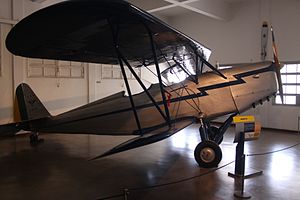Muniz M-7
| Muniz M-7 | |
|---|---|

| |
| Role | Primary trainer |
| National origin | Brazil |
| Manufacturer | Companhia Nacional de Navegação Aérea (CNNA)
|
| Designer | Antônio Muniz |
| First flight | 1935 |
| Primary user | Brazilian Air Force |
| Number built | 28 |
The Muniz M-7 was a two-seat primary training biplane with tandem open cockpit and powered by a 130 hp (197 kW)
Companhia Nacional de Navegação Aérea (CNNA) at Viana Island, (Rio de Janeiro). 11 aircraft were flown from 1937-1941 by the Military Aviaton School based in Campo dos Afonsos, with the remaining 17 aircraft being sent to flying clubs.[3][2]
Operators
Specifications (M-7)
Data from Jane's All the World's Aircraft 1938[4]
General characteristics
- Crew: 2
- Length: 7.24 m (23 ft 9 in)
- Wingspan: 9.00 m (29 ft 6 in)
- Height: 2.85 m (9 ft 4 in)
- Wing area: 20.1 m2 (216 sq ft)
- Empty weight: 560 kg (1,235 lb)
- Gross weight: 860 kg (1,896 lb)
- Powerplant: 1 × de Havilland Gipsy Major , 97 kW (130 hp)
Performance
- Maximum speed: 190 km/h (120 mph, 100 kn)
- Cruise speed: 150 km/h (93 mph, 81 kn)
- Endurance: 5 hours
- Service ceiling: 4,000 m (13,100 ft) (absolute ceiling 5,200 m (17,100 ft))
See also
Related development
Related lists
- List of Interwar military aircraft
References
Wikimedia Commons has media related to Muniz M-7.
- ^ "Muniz M-7 / M-9".
- ^ a b "Muniz M7 | Fábrica Brasileira de Aviões - MUSAL".
- ^ "7 Muniz M-7". Archived from the original on 2016-12-20.
- ^ Grey & Bridgman 1938, p. 12c
- Grey, C. G.; Bridgman, Leonard (1938). Jane's All the World's Aircraft 1938. London: Sampson Low, Marston & Company, Ltd.
- Taylor, Michael J. H. (1989). Jane's Encyclopedia of Aviation. London: Studio Editions.
- The Illustrated Encyclopedia of Aircraft (Part Work 1982-1985). Orbis Publishing.
